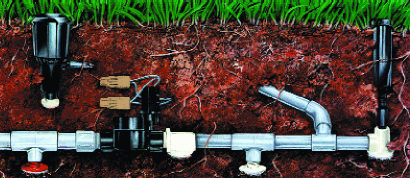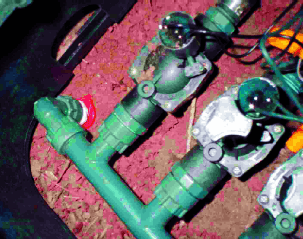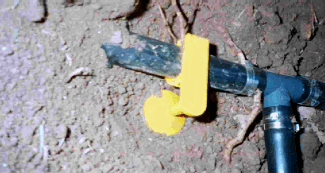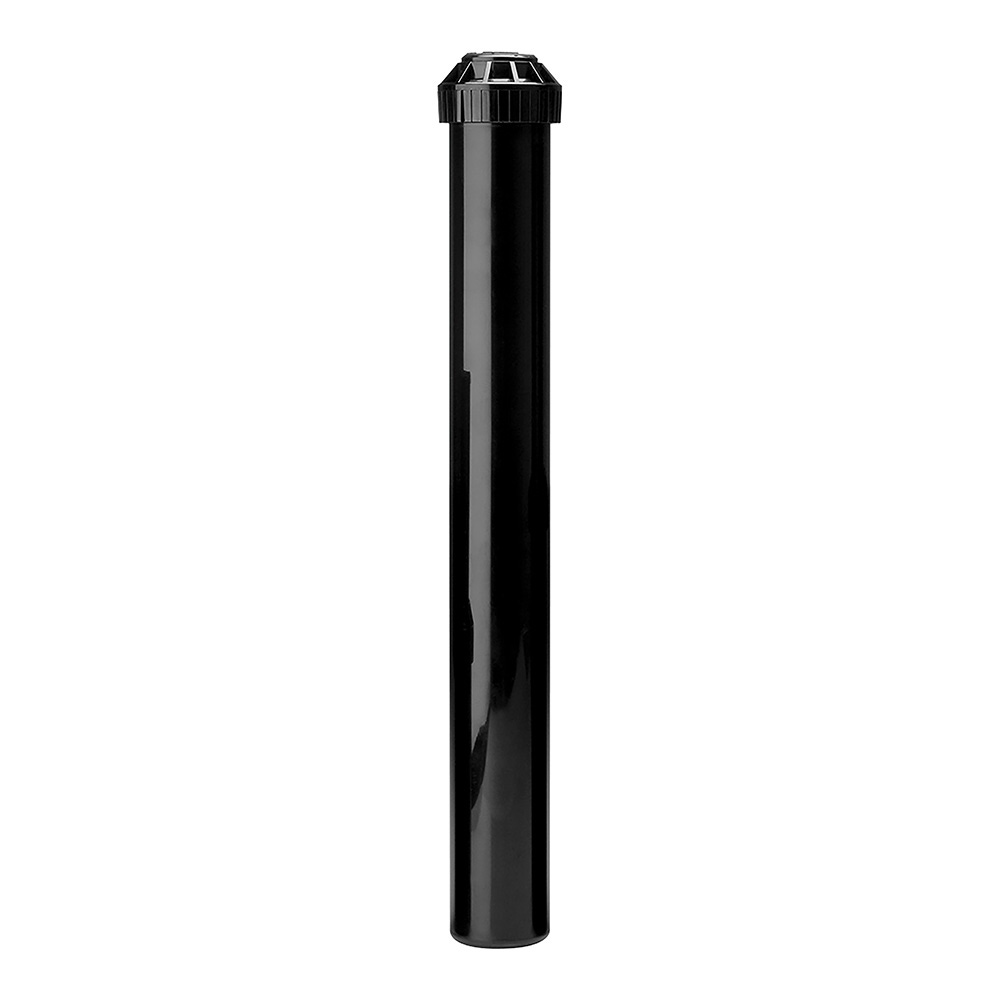How Freeze Drains Work

This has been a tough year for contractors, especially for those who do winterizations. The weather doesn’t break for most parts of the northeast and central states until mid-April. Due to this long layoff, they have had to crunch to get the work done. This is how they bring in new business. Hopefully, the weather will cooperate and they can work late into the fall. This article explains how the freeze drain works and why it is irrigation’s best kept secret.
Professional contractors are already beginning to think about scheduling their winterization programs. They do this to avoid a crunch for time as the temperatures drop. Some contractors have found a way to decrease their stress level, and to a degree, stave off winter. They use the freeze drain which is irrigation’s best-kept secret for winterizing. The freeze drain is also known as the automatic drain valve.
Automatic Drain Valve
Automatic drain valves can play a significant role in conserving time and labor for both the contractor, and customers. The valve enables contractors to start installing sooner in spring and work later into the fall installation season.
The drain valve works very simply. Most use a pressure-activated rubber valve that closes when the psi reaches 9 or 10. When the zone cycle ends and shuts off, the resilient rubber valve reopens and a portion of the water drains out. This provides valuable freeze protection.
A Brief History
Automatic drain valves are not new to the irrigation industry. Lloyd King invented and introduced them to the market in 1970. His son, Herb King, continues production under his company’s name, King Safety Products, after revising the drain in 1992. Seven years ago, Tom King of Tom King Harmony Products, another son of Lloyd’s, came up with a new automatic freeze drain design. He calls it the Harmony Drain.
“The contractor doesn’t need a gravel sump anymore unless installing in extreme clay conditions,” explains Tom King. “All soils are suitable for drainage. We recommend mounting lateral line drains at a 45-degree angle to keep any dirt that may be in the system out of the drain.”
“In the spring there is always a chance of contaminated water running back into a pipe,” says Herb King, “but these drains are designed with a backflow check; water comes out, but can’t go back in. The earth wicks the water out of the pipe, but you don’t want the dirt going back in.”
Freeze Drains
Freeze drains are used on both polyethylene and PVC pipe. They are installed on the main line, the lateral lines, the middle of the lines, the end of the line and any additional low spots along the pipe. Three per zone is a typical installation. Settling some concerns over whether drains will work long-term, Herb King advises that there are systems over thirty years old still being protected with King Drains. “It is the only auto drain with both critical features, backflow check and dirt intrusion.”
The mainline automatic freeze drain valves are designed to handle up to 1200psi and the lateral line automatic freeze drain valves are designed to handle up to 1000psi, to eliminate damage to the drain caused by the water hammer.

The Harmony drain has a built in self-cleaning operation; when the pipes start to fill, a small precision-ground PE rubber ball bounces around inside the automatic freeze drain valve, eliminating any dirt in the system from clogging the freeze drain. Both drains have the wicking action drain pad that protects against root intrusions and sharp rocks.
Advantages Of The Automatic Freeze Drain
There are several advantages to making automatic freeze drains a standard part of your systems. You can advertise your systems as automatic drain systems. In addition, you can also offer a 100% warranty against freeze damage. Not only do you offer your client security against freezing pipes, it is very profitable as well.
How Popular Is This Practice In The U.S.A.?
In writing this article, it was interesting to note that as we telephone-traveled from east to west, we found that in certain areas of the country they use automatic freeze drains extensively. In other areas they’re not used at all, and still others use them in “special circumstances.” In many cases, whether automatic freeze drains are installed or not, it depends on who trained the contractor in irrigation installation. This explains why there may be entire regions in a state that do or do not use automatic freeze drains and why the freeze drain is being called irrigation’s secret. The predominant number of contractors using automatic drains was in the Midwest, and where wintertime freezing frequently occurs.
Another advantage is in winterizations. Automatic drains give your customers a longer fall and an earlier spring watering season, protecting their systems against premature freezing. You can blow out more systems in less time because the lines have already been drained. With this time savings, you are able to install systems later into the season, thereby avoiding the normal crunch, when everyone wants their systems winterized at the same time.
In some areas of the country, contractors are not blowing the systems out if they have installed automatic freeze drains. As they explain how to operate a new system to the homeowner, they also explain how to drain the main line when the system is ready to be shut down for the winter. They give the homeowner a handout explaining the steps for shutting the system down and bringing it back up in the spring.
Hear From The Contractors Themselves
“Most of my customers like this idea,” says Mark Alexander, owner of Tri-City Sprinklers in Grand Island, Nebraska. “If they know a hard freeze is coming, they can drain the system, shut it down, and then, if in the next week or so it warms up and they want to water, they can bring it up by themselves, without having to pay me for service calls. The following spring, they can turn it on whenever they are ready to use it. They like that independence.”

Brandon Phelps, owner of Magic Lawe in Bountiful, Utah, says, “It doesn’t take an extra minute on each line to install automatic drains. I guarantee my work for three years, and I just like doing it right the first time.”
In New Jersey, a spokesman for Princeton Irrigation stated that unless someone specifies it, automatic drains are not installed, except where there are exposed risers. In Pennsylvania, a contractor who installs in a very rural area feels automatic freeze drains are a “good thing to use” but his clients have a low price in mind for what they want to pay for a system and he can’t include automatic freeze drains. He blows all his systems out, even those with automatic freeze drains, as a safety measure.
Ted Schellhase, owner of Lake Front Landscape in West Point, Utah, says he installs freeze drains in special circumstances. He uses polyethylene pipe and he says that when coming down a hill he will place a drain past the last sprinkler at the lowest point. He blows all his systems out.
“I advertise my systems as self-draining,” says Jerry Lamner, owner of R & L Sprinkler in Grand Island, Nebraska. “This is upselling, but most reputable companies in our area install freeze drains. Extending the season is not necessarily a factor; the big factor is keeping the backflow from freezing.” Lamner does not blow out his customer’s systems. Instead, he shows them how to relieve the pressure, preferring to save his clients money on service calls.
Standard Procedure
“Installing automatic freeze drains is standard procedure with my irrigation systems,” explains John Yowell, owner of Modern Underground Irrigation in Lincoln, Nebraska. “I don’t give my clients a choice. I give them an instruction sheet for draining the system in the winter and have had positive responses. They know how much money they are saving in service calls, and I like not having the stress in the fall and spring scheduling shut downs and start ups.”
The majority of contractors interviewed across the nation still blow out their clients’ systems. Some were not aware of the existence of automatic freeze drains; some had heard of them but did not have enough information to try them; others had heard about them but had concerns about failure and felt that if they failed, it would be too late, pipes would be frozen.
Spread The Word And Stay Informed!
The freeze drain is still irrigation’s best-kept secret. It’s time they came out of the closet! Add security to your irrigation systems for your customer’s peace of mind. Upgrade the systems with automatic freeze drains to rise above the competition. Don’t be afraid to ask questions to find out if they are conducive to your area’s climate. Learn about the changes and advancements that have been made since the ’70s. With this knowledge, you can easily make the systems you install state of the art.
Click here to shop backflow winterizer valves, insulated pouches, repair parts and more.


























